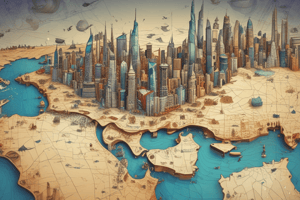Podcast
Questions and Answers
Which concept describes the notion that individuals acting in their self-interest can lead to beneficial economic outcomes for society?
Which concept describes the notion that individuals acting in their self-interest can lead to beneficial economic outcomes for society?
- Wealth Redistribution
- The Invisible Hand (correct)
- Social Darwinism
- Collective Responsibility
How did Max Weber characterize the essence of capitalism?
How did Max Weber characterize the essence of capitalism?
- The continuous, rational pursuit of profit through enterprise (correct)
- A historical accident shaped by family lineage
- A system driven by benevolence and moral obligation
- An inevitable force of nature leading to economic downfall
What is one of the main critiques Karl Marx had regarding capitalism?
What is one of the main critiques Karl Marx had regarding capitalism?
- It encourages excessive regulation of free markets
- It fosters community and collaboration
- It leads to alienation of workers from their labor (correct)
- It is fundamentally a sustainable economic model
What defining feature distinguishes the first 'capitalist' societies according to historical analysis?
What defining feature distinguishes the first 'capitalist' societies according to historical analysis?
Which of the following is NOT one of the '5 Cs' of the Historical Approach as discussed?
Which of the following is NOT one of the '5 Cs' of the Historical Approach as discussed?
What was a primary characteristic of the manorial/seignorial system in the European Middle Ages?
What was a primary characteristic of the manorial/seignorial system in the European Middle Ages?
What shift did the Vikings contribute to in trade during their era?
What shift did the Vikings contribute to in trade during their era?
Which of the following was NOT a consequence of the Black Death in medieval Europe?
Which of the following was NOT a consequence of the Black Death in medieval Europe?
During the High Middle Ages, how did the Church contribute to the economy?
During the High Middle Ages, how did the Church contribute to the economy?
What major societal change did the proverb 'l'argent n'a pas de maître' signify?
What major societal change did the proverb 'l'argent n'a pas de maître' signify?
Flashcards are hidden until you start studying
Study Notes
Course Introduction
- Global History: The Development of Global Economic Structures from the 13th to 18th Centuries
- 9 Session Course: Course Introduction; Economic Origins in Venice; Asian Development in the Song Dynasty Period; Iberian Global Expansion; Amsterdam and Globalism; The Growth of Atlantic Colonial Trade; Slavery and Triangular Trade; Empire and Industry; A Review
The Big Questions
- What is Capitalism?
- Why are some countries rich and others poor?
- How are capitalism and the development of the modern world linked?
- What was the first “capitalist” society?
- 5 Cs of the Historical Approach: Change Over Time, Causality, Context, Complexity, Contingency
Towards a Working Definition of Capitalism
- Marx: labor power, production, and alienation
- Weber: rational, peaceful free exchange to pursue renewed capital
- Smith: the pursuit of self-interest and the “invisible hand” of the free market
- Braudel: the “anti-market”, a centralization of power, an adaptation into social hierarchies
Capitalism vs Mercantilism
- Mercantilism: A single global pie, shared by all
- Capitalism: An ever-expanding pie, growing from competition
The Foundations of Capital in the European Middle Ages
- High Middle Ages (900-1300)
The Manorial/Seignorial System
- Highly Centralised: An efficient centre of law, power, military
- Violent social control and limitation
- An extension of feudal power
- Peasant-based subsistence farming
The Church as a Centre for Trade
- Quasi-government after the Roman Empire
- Patronage and Investment: artists, scholars, and craftsmen, which stimulated innovation and trade
- Banking and Finance: Religious institutions provided safe storage for wealth
- Trade Routes and Infrastructure: waypoints along trade routes, offering shelter
- Education and Literacy: a skilled workforce contributed to the growth of trade and economic activities
The Vikings
- Replacing Roman Trade in the West
- Highly Mobile
- Long Range expeditions
The Results of the Viking Age
- New Trade Routes
- Inter-European Diplomacy
- The Militarisation of the Church
- Kingdoms established along defined borders in the East against other “barbarians”
Pax Europa?
- Internal Strife vs External Conflict
- Centralization of power and the beginnings of “national” identities
- Opportunities for inter-community trade and travel
- The Crusades largely ended war inside Europe
The Black Death (1346-1353)
- Killed around 50 million people (anywhere between 35-60% of the population of Europe)
- Brief end to long-distance trade
- Reduction in economic inequality
- Long-term: High wages as a drive for innovation
- Increased potential for wealth and freedom
- The eventual end of serfdom
- Urban growth
Women in the European Medieval Economy
- Wives and mothers (Biblical)
- Property rights as a tool of power
- Basic textile and agricultural industries
- Brief possible “golden age” after the black plague
Studying That Suits You
Use AI to generate personalized quizzes and flashcards to suit your learning preferences.




